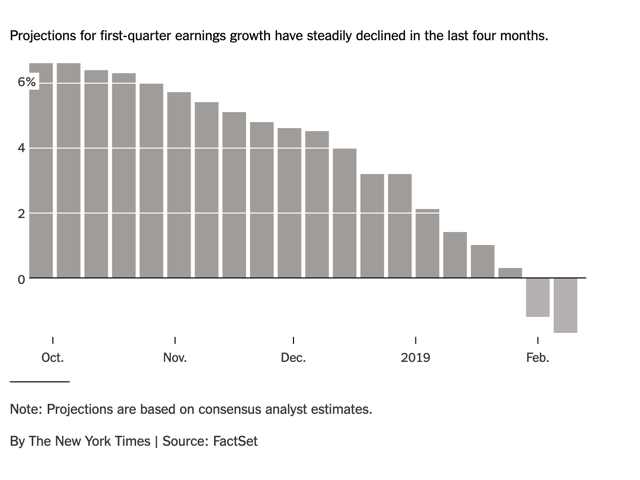Earnings were boosted by corporate tax cuts in the past year. And earnings growth has been buoyed by significant corporate releveraging. But 2019 is looking challenging for companies now and the chart below shows you why.

While earnings growth came down during the period of market jitters in October through December, earnings are expected to contract. Here’s the New York Times’ Stephen Grocer:
Fears of a looming United States recession have subsided, with investors taking comfort that the Federal Reserve will continue to support economic growth.
But warning signs keep flashing about the shaky fundamentals of the economy and therefore the stock market. The latest alarm bell is that Wall Street analysts are slicing their forecasts for how much big companies will earn in the months ahead.
Halfway through the first quarter of the year, analysts now expect profits of companies in the S&P 500 to decline by 1.7 percent from the same period last year, according to data from John Butters, senior earnings analyst at FactSet.
That is a sharp reversal from the start of 2019, when the same analysts predicted that corporate earnings would rise by 3.3 percent compared with the first quarter of 2018.
I think there is considerable downside risk to these numbers due to the potential for a trade war either between the US and China or the US and the EU. The question would be what companies do as a result of declining earnings, given balance sheets already stretched by releveraging. If we get inventory purges, production downshifts, and job losses, and consumption growth declines, I think we are close to recession. And then we would have a second (and likely another) round of bloodletting.
The positive for earnings here is that monetary policy has now moved to easing from tightening. And that’s not just in the US, it’s globally. The ECB and BoE have also turned more dovish, due to economic jitters and Brexit. And Bank of America Merrill Lynch strategists looked at EM central banks and found their policy statement language to be the most dovish since 2009, due to fears of Chinese weakness infecting other economies.
On balance though, I think the balance sheet constraints of US corporates and the lateness of the business cycle trumps monetary easing. And so, the downside risk to earnings remains the predominant one in 2019. For me, that means the recent downturn that ended in December was not an opportunity to ‘buy the dip’. Instead, the recent rally in equities is an opportunity to cut positions and gain a more defensive posture in anticipation of more to come.
Comments are closed.